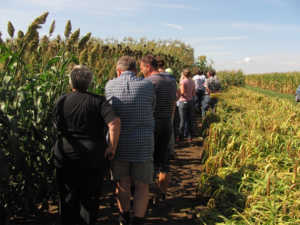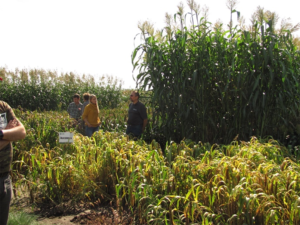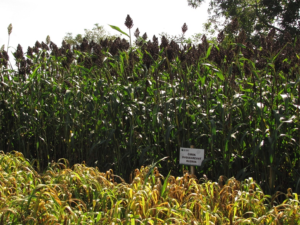Sorghum silage in dairy farming. What are the benefits?

On September 22th 2020, the Ivanovice na Hané experimental station of the Prague-Ruzyně Crop Research Institute offered a complete program on silage sorghum and its benefits in dairy farming: trials, presentations and numerous exchanges on the stands allowed visitors to gather very broad information on this culture still little known in the country. They were greeted by the manager of the station Miroslav Janeček and his team of technicians, as well as representatives of the company Seed Service, which is a pioneer in the Czech Republic having been developing sorghum since 2008.
The presentations focused on:
- The characteristics of sorghum and the different types of silage
- The many similarities between sorghum and corn silage: yield, palatability, high fiber content and digestibility, high proportion of hemicellulose, positive effect on rumen metabolism and on herd milk productivity.

Sorghum for silage and fodder production
Sorghum is used to make haylage and silage in the Czech Republic. Unlike biomass types, silages from grain sorghum have similar energy content as maize silages due to their higher starch level, so they are also used to feed dairy cattle. The most grown sorghum species are Sorghum bicolor bicolor and Sorghum bicolor drummondii. For Sorghum bicolor bicolor 3 main type of varieties are cultivated: grain sorghum, sweet sorghum (sugar) and biomass sorghum (fiber). For the species Sorghum bicolor drummondii also called Sudan grass, the varieties are grown as multi-cut for haylage or single cut for silage.

Hybrids of grain or sweet sorghum with Sudan grass are grown for biomass production – as multi-cut for haylage or single cut one for silage. At maturity, depending on the variety, they most often reach a height of 2.5 to 3.5 meters. In a two-step harvest for haylage, they are sown in narrow rows and provide semi-protein forage with a high content of digestible fiber and sugars. When they are grown for biogas, they are harvested in a single cut. For multi-cut use (haylage) or to produce silage in worse conditions, Czech breeders developed an early drought-resistant variety. The variety has a rapid initial development and growth after harvest. Its leaves and stalks are sweet and juicy, so the cows willingly eat them. BMR variety offers an extremely high digestibility of the whole plant.

The abbreviation BMR, Brown Mid Rib, describes a gene mutation discovered in maize as early as 1927, which changes the structure of cell walls and causes the middle rib of leaf to turn brown, indicating a disorder of lignin deposition. By forming of lignin, which reinforces the stems and thus reduces digestibility, the plant protects itself from lodging. Specially bred BMR varieties have 40 to 60% less lignin, their digestibility is higher by 15 to 30%, which helps higher feed intake” explained Ing. Podrábský, a sales representative and agronomic consultant in SEED SERVICE Ltd.
Grain sorghums are suitable for grain production or for single-step silage harvesting. They grow to 0.8 to 1.2 meters. In ideal conditions, they yield up to 10 t of grain / ha. Their grain is dried because the water content at harvest is 16 to 22%. Czech and European breeding companies offer very early varieties with tannin-free grain for grain production. Grain silage types have a height of 1.5 to 2 meters. In particular, BMR types have excellent digestibility. They are ensiled at milk maturity at a plant dry matter of 25 to 27%.

In the case of multi-cut use of biomass sorghum, Ing. Podrábský advised to cut it with a forage harvester equipped with a large saw-like blades, let it wither quickly and then harvest semi-protein haylage, which ferments quickly thanks to homofermentative lactic acid bacteria. Another option is to harvest biomass at maturity, but the problem is the low energy value of common varieties. He recommended biomass sorghum neither for feeding to dairy cows nor for biogas production. For “dried off” cows and heifers, he suggests BMR sorghums, which have 2 to 8% higher fiber digestibility. „It is a big difference that will ensure a higher nutrient intake in ruminants,” he stressed.
Continue ?
Each market its own sorghum. Do you know them?

Sorghum all around













